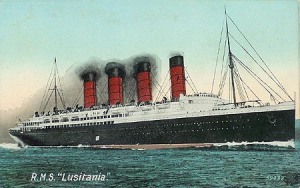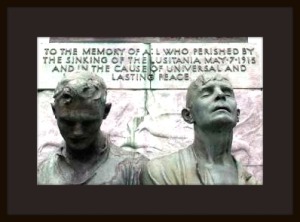 The Lusitania, a British registered vessel, was sunk by a torpedo that changed the course of history. It took just eighteen minutes to go down. Today, May 7th, 2015 is the one hundredth anniversary of that tragic event. One of the passengers was widower George Hook, travelling with his two children, Elsie and Frank. On board was another family, Walter and Nettie Mitchel and their baby son, along with Nettie’s brother, John.
The Lusitania, a British registered vessel, was sunk by a torpedo that changed the course of history. It took just eighteen minutes to go down. Today, May 7th, 2015 is the one hundredth anniversary of that tragic event. One of the passengers was widower George Hook, travelling with his two children, Elsie and Frank. On board was another family, Walter and Nettie Mitchel and their baby son, along with Nettie’s brother, John.
The German u-boat U20 was headed towards a war zone in Irish water, where its mission was to sink any British ship in its path. Travelling to the same area at a top speed of 25 knots was the Lusitania, nicknamed The Greyhound of the Sea. U-boats were designed to attack slow moving targets, so speed was considered an advantage in avoiding their missiles.
A one hundred year old document, written by Captain Walther Schweiger while on board U20, outlines the course of its mission. It sank a schooner and two merchant ships before encountering the Lusitania. No escort was sent to meet the massive liner, as it was considered more of a risk slowing down to accompany a smaller vessel. Unfortunately, a heavy fog forced the big ship to decrease her speed. When the fog lifted the ship was close to the coast of Ireland, and passengers could see the Old Head of Kinsale.
At one o’clock in the afternoon, U20 surfaced before beginning its journey home and spotted the Lusitania. The ship received a warning of a German u-boat in Irish waters and Captain Turner changed course from Liverpool to Cobh. The Lusitania was travelling at 22 knots. Never had the u-boat hit a target at that speed before. Its missile, cutting through the water at forty miles an hour, struck it’s target in less than a minute.
At ten past two the torpedo punched a hole in the side of the ship. A secondary explosion occurred, much stronger than the first, most likely caused by a ruptured steam pipe, according to some accounts.
One of the passengers, French actress Rita Jovilet, was carrying a small revolver because of her fear of drowning. Nettie and Walter Mitchel and their baby son had no life jackets and managed to get into a lifeboat, but there were no bungs and it began to sink. The couple were left clinging to an upturned boat in freezing water. The ship was carrying seventy lifeboats and rafts but the severe listing prevented most of them from being launched. Boats were landing upside down, and on top of people who were already in the water. George Hook decided it was too dangerous to get into a lifeboat and told his children to prepare to jump.
Sixteen minutes after the impact, the deck that the Hook family were on was almost in the water. When it reached their feet George told his children to jump but Frank got separated from his family in the sea.
At twenty-eight minutes past two, the Lusitania sank beneath the waves, more than eleven miles (18 kms) from shore.
Two hours later a rescue boat still hadn’t arrived and the survivors in the water were freezing. Only six of the forty-four lifeboats had been successfully launched. The French actress was in the water, clinging to an upturned life boat, as was Nettie and Walter. Their baby son died from exposure, in his father’s arms. Eventually, Walter said he couldn’t hold on any longer and slipped away. Three hours after the Lusitania went down, fishing boats were the first vessels to arrive on the scene to pluck 764 survivors from the sea.
George and Elsie Hook spent three days looking for young Frank’s body, until a man told them about a boy in a hospital with a broken leg, caused by a falling lifeboat. When they found Frank the first thing he is known to have said to them was, ‘It took you long enough to find me.’
Nettie’s brother John had been picked up by a tugboat and brought to Cobh. He found his sister left for dead among some of the bodies, but thought he saw her eyelids flutter. You can read Nettie’s story here.
French actress, Rita Jovilet, did not shoot herself as intended, but survived to star as herself in the movie Lest we Forget.
Tragically 1,198 perished, including three stowaways, a higher percentage than on the Titanic. Ninety-four of them were children of which thirty-one were babies. The dead were washed up on the Cork coast for weeks afterward. There is a monument in Cobh as a memorial to those who perished. Check out The Lusitania Resource to find out more about her passengers and crew. It will take you longer to browse through the site than it did for the ship to sink.



How horrible. I never knew the story, so am glad to know more about it.
LikeLiked by 1 person
I knew very little about the Lusitania, Jean, so thank you for publishing this post.
It’s strange that most people know more about The Titanic than they do The Lusitania, especially when many more people perished.
LikeLiked by 1 person
Maybe it’s because the Titanic went down as the result of an accident and in peacetime, that it stands out in history. The poor old Lusitania is usually counted among a long list of casualties of WW1. That might be why she doesn’t seem to get as much attention as Titanic.
LikeLiked by 1 person
Very true, I never thought about it that way. I didn’t realise either that The Lusitania was carrying ammunition. I don’t know if that is true but it is something I have read online.
LikeLiked by 1 person
The UK attempted to demolish the wreck decades ago, but (as of 1982) there were still tons of unexploded torpedoes, etc., aboard. IIRR, Germany placed ads in NY newspapers warning that the Lusitania was hauling munitions, and was a ship of war by their definition. It was not surprising that it was attacked. What was surprising was that a passenger ship would cynically be used for such materiel.
LikeLiked by 2 people
So wrong, hiding behind civilians like that. Still happening today.
LikeLike
Reblogged this on Ms M's Bookshelf and commented:
This past week was the 100th anniversary of the sinking of the Lusitania. Here is an excellent retelling of the event by Irish author Jean Reinhardt. It’s good to remember.
LikeLiked by 1 person
Thanks so much for the reblog. I live near Cobh but it’s the town’s connection with the Titanic that everyone remembers.
LikeLike
Great post, I saw a documentary on this on Rte a few weeks ago and am hoping to visit the Old Head this weekend to see the memorial there.
LikeLiked by 1 person
I saw that documentary too, Joan. I based my blogpost on it as I had never heard the story of those passengers and figured not too many people had.
LikeLiked by 1 person
Me neither. It was very interesting.
LikeLiked by 1 person
Tragic so very sad. Living in such a peaceful era and country I couldn’t imagine these senseless attacks.
Learning about history through your words has been extremely educational for me. Thank you Jean!
LikeLiked by 1 person
My dad told me some stories of his WW2 childhood in the north east of England, Motoko. He doesn’t remember feeling afraid too often but his parents definitely remembered how scary it felt during an air raid. There is always some place in the world under attack at any given moment. As you say, utterly senseless.
LikeLike
Such a senseless tragedy. Thanks for the account.
LikeLiked by 1 person
Bad enough that those serving lose their lives but there are often even more civilian deaths in war, Dan. What a terrible price to pay.
LikeLiked by 1 person
good read!
LikeLiked by 1 person
Thanks, Jim.
LikeLike